Judith A. Yates's Blog
December 6, 2021
Another School Shooter: “Blood everywhere. The thoughts won’t stop. Help me.”
Days later, Ethan Crumbley walked into Detroit’s Oxford high school to unleash hell: At least 30 shots from a Sig Sauer 9mm, an early Christmas gift from his parents. Eleven people suffered gunshots. Madisyn Baldwin, 17; Tate Myre, 16; Hana St. Juliana, 14; and Justin Shilling, 17, will never walk the school halls again. The 29th school shooting in 2021, the 21st since August 1, was etched in history.
What makes this school shooting most historical is the arrest and charge against Ethan’s parents Jennifer and James; they were charged on December 3 with involuntary manslaughter for failing to secure the Sig Sauer 9mm. “It’s just not enough to charge this shooter,” Oakland County Prosecutor Karen McDonald told the public. Jennifer and James failed to appear for the arraignment, attempted to flee, and became the subjects of a search by the U.S. Marshals. They would be caught and arrested in Detroit on December 4. The Crumbley parents became headlines.
 Ethan Crumbley mug shot. Picture: Oakland Co. S. O.
Ethan Crumbley mug shot. Picture: Oakland Co. S. O.Ethan Crumbley revealed leakage in his artwork, journal, and video, where he drew pictures of people, shot and “details his ‘desire to shoot up the school to include murdering students,’” according to authorities; there were “two videos on Crumbley’s phone that were recorded … about shooting and killing students at the high school….” School officials held meetings with the parents regarding some of the artwork. Only so many hours later, the boy was making a different kind of video where school cameras recorded him casually walking down the halls of Oxford, pointing the 9mm into classes and squeezing off rounds.
“It was absolutely premeditated,” Karen D. McDonald has announced. Ethan Crumbley is charged as an adult with one count of terrorism causing death and four counts of first-degree murder. He is looking at a life sentence if convicted.
All we know about this case is what the “officials” – and the media – are telling. This includes information about Jennifer, James, and Ethan Crumbley. From what we have been told, we see Ethan’s case was ignored or passed over by school authorities and parents to the point where lives could have been spared. The result is that four children are buried, a family loses their parents, and a boy will become an old man in prison. Guilt will forever ride the shoulders of so many. Everyone finds someone to blame to ease their pain. No one wins.
What is most important about this school shooting? What seems most revealing, what we should all concentrate on, are the two words revealed in Ethan’s artwork: “Help me.”
September 12, 2021
Was England’s Elward Medhurst an “English Jesse Pomeroy”?
In the September 6, 1894 edition of the Journal Times (Racine, WI) a short paragraph appears on page 2 announcing that England has its own Jesse Pomeroy.
 Jesse Pomeroy, America's "boy fiend"
Jesse Pomeroy, America's "boy fiend"Jesse Pomeroy has a permanent place in the American history books of crime. From 1871 to 1872, Charleston, Massachusetts boys reported being lured to a remote area by an older boy, then beaten and sexually assaulted. The brutality of the crime made the reports particularly notable. While there were no arrests, Jesse’s mother moved twelve-year-old Jesse and his brother to Boston. Jesse attacked more children and was caught and sentenced to a reformatory. On parole at fourteen, Jesse lured a ten-year-old girl away from the public, beat her, mutilated the corpse, and hid the body. Pomeroy was arrested, tried, and sentenced to hang; the sentence was overturned to life in prison in solitary confinement. Jesse Pomeroy spent over fifty years in State Prison at Charlestown. He was deemed to be highly intelligent, attempted escape several times, and died in the Bridgewater State Hospital for the Criminally Insane in 1932.
“A case of juvenile depravity”
In 1894, five-year-old Elward Medhurst of London was reported to have stabbed six children in one month. The victims were around five years old. One of these children died. Other children “escaped his attacks.” Elward’s path seemed to be mirroring that of Jesse Pomeroy, except he was caught before the crimes escalated.
“A case of juvenile depravity” an unknown author reports, and Elward was examined by a “medical commission” that determined the boy was “incurably afflicted with homicidal mania.”
While Pomeroy was the stuff of headlines and bylines throughout his life, Elward Medhurst appears in
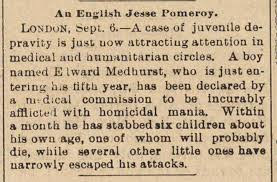 Journal Times (Racine, WI), 09-06-1894
Journal Times (Racine, WI), 09-06-1894only a few newspapers in the same short paragraph. After that- nothing.
Did Elward Medhust’s older years parallel that of his American counterpart? The files are long gone, tucked away in history, survived only by a small news story.
August 13, 2021
Woman pregnant with twins goes missing. And then…

The plea went out over social media, local news and spread across a community. Where was Elizabeth “Liz” Jasso? She was last seen leaving to visit her husband Milko’s grave before arriving at the hospital for induced labor. At 40-weeks pregnant, her loved ones feared for her safety, mainly because Milko “Cash” Jasso was murdered six months prior. And then ...
Milko “Cash” Jasso had proposed to Liz over what sounds like a jail telephone. Milko had a daughter from another relationship, who Liz called “my first love.” They settled down in wedded bliss, with Liz posting over social media how much she loved her husband, his family, and her friends. Liz became pregnant with twins. And then...
Milko was rarely loyal, and it cost him. In February 2021, Milko lay dead in a lover’s bed after the lover’s husband caught them. Still, loyal Liz grieved, posting her grief for all to see on social media. There was no love like the love she and Milko shared, she insisted. Liz held a GoFundMe for funeral expenses:

A professional photographer completed a photoshoot with Liz’s stepdaughter kissing Liz’s swollen tummy, and a much-revered special effects photo:

Following a trend, Milko’s family held a gender reveal party for Liz. The celebration was at Milko’s gravesite. “Everyone [sic] please wear white shirts,” Liz requested on Facebook. “Cash” and “Royalty,” both boys, would be well-taken care of – the family was already providing everything Liz needed. Then came the baby shower, a deluxe party with gifts, food, music – so many people celebrated. They took pictures of themselves with Liz, proudly placing their hands on her pregnant tummy. Over 75 photos appeared on Liz’s Facebook:
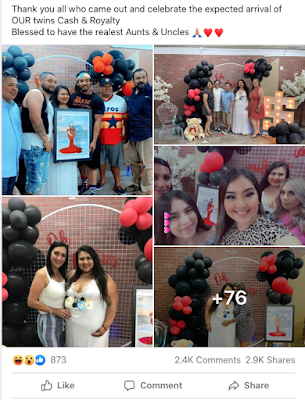
Meanwhile, Liz’s in-laws cooed and smiled over the ultrasounds she brought them. They wished her well during the doctor’s appointments. They patted her tummy. All the while, the family supported her financially. And then…
An August 4, 2021, Liz announced:
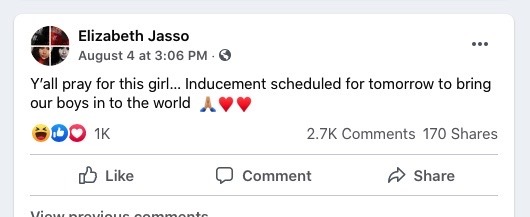
Before arriving at the hospital, Liz wanted to visit Milko’s grave. She drove her white BMW, promising everyone she would be sending photos of the newly arrived Cash and Royalty. And then she was - gone! Frantic social media posts and news reports appeared. Missing Persons organizations jumped in to assist. Facebook pages were created. Where was Elizabeth “Liz” Jasso? Where were the twins? And then …

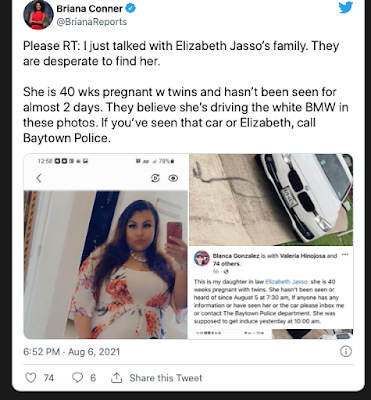
Liz’s parents and a sister came forth to admit the truth: Liz had physical issues that prevented pregnancy. Investigation revealed Liz had purchased ultrasound images online. She most likely bought a “Fake Pregnancy Belly”:
 from Amazon.com
from Amazon.comThe doctor’s visits, the physical ailments, the future sons “Cash” and “Royalty,” the pregnant mommy life, the social media posts – all lies. An elaborate hoax. Elizabeth “Liz” Jasso would turn herself in to authorities. The case is ongoing. There are arguments she suffers from mental illness. People continue the saga on social media to express shock, anger, disgust, embarrassment. The pregnancy was now as transparent as Milko in the couple’s photo, but few believed their loving Elizabeth could pull such a stunt. And then…
The story continues - via Facebook, Twitter, Instgram…
(All photos appear on Facebook)
August 8, 2021
The Terrible Story of Grace Budd – Victim of Albert Fish
It was a cold November 1934 when Delia Flanagan opened the unsigned letter. Illiterate, she asked her oldest son George to read it. “Dear Mrs. Budd,” the author wrote, “On Sunday, June the 3 — 1928, I called on you at 406 W. 15 St. Brought you pot cheese — strawberries. We had lunch. Grace sat in my lap and kissed me. I made up my mind to eat her.”
The letter also included, “I took her to an empty house in Westchester I had already picked out ... I told her to remain outside. She picked wildflowers,” the letter continued. “I went upstairs and stripped all my clothes off ... I went to the window and called her. When she saw me all naked she began to cry and tried to run. I grabbed her and she said she would tell her mamma” [sic].
 The anonymous letter to Delia Flanagan
The anonymous letter to Delia Flanagan
No doubt, Delia felt a wave of terror as she read the strange ramblings. Her 10-year-old daughter, Grace Budd, had been missing for six years with no sign of locating the child. One of five children, Grace was last seen departing her Manhatten home with an unassuming older man who invited her to his niece’s birthday party. They were to return later to drop off Grace and pick up her brother, Edward.
The man, introducing himself as “Frank Howard,” had initially arrived at the Budd home, following exchanged telegrams, to speak with Edward, sixteen, about a job. Frank Howard reported he owned an upstate Farmingdale home.
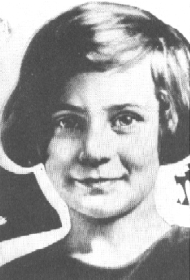 Grace Budd
Grace Budd
“Gracie” instantly warmed to Mr. Howard. She sat in his lap as Mr. Howard raved about his farm and all its trappings- animals, fresh air, six happy kids, and healthy food.
Now, skipping happily next to her new companion, Grace, in a white silk dress with matching socks, a white felt hat, and a grey coat trimmed with fur, clutched her brown pocketbook in one hand and the stranger’s hand in the other. She was anticipating a fun day filled with birthday surprises and lovely treats. What she got was Albert Fish: sadistic serial killer of children, AKA “Frank Howard,” her new companion who now held her hand.
The Budd family struggled to feed and clothe their children Beatrice, Albert Bud II, Grace, George, and Edward. Grace was a withdrawn, sickly child, possibly due to their lifestyle. They were another poor family living amongst other low-income families in Manhattan’s Meatpacking District at 406 West 15th Street, a tenement; the stench of factories and slaughterhouses filling the buildings with a dank odor. Father Albert worked as a porter. Thus, a wealthy, kindly man doing a favor for their family was the answer to Delia’s constant prayers. “Mr. Howard” was now considered a family friend.
The anonymous letter to Delia Flanagan ended: “First, I stripped (Grace) naked. How she did kick, bite, and scratch. I choked her to death, then cut her in small pieces so I could take the meat to my rooms, cook, and eat it. How sweet and tender her little a** was roasted in the oven. It took me 9 days to eat her entire body. I did not f*** her, though, I could of had I wished. She died a virgin” [sic]. He later confessed to dismembering Grace with a saw and meat cleaver.
“He was so kind and fatherly"
When Grace never came home, the family initially thought there had been an accident, until police told them there were no recorded accidents of an old man and a little girl, and there was no “Mr. Frank Howard.” The Budds could recall a general description of “Mr. Frank Howard,” the alias Albert Fish used upon meeting the Budd family.
After notifying law enforcement, Grace’s “missing” poster was all over town and then the country. It
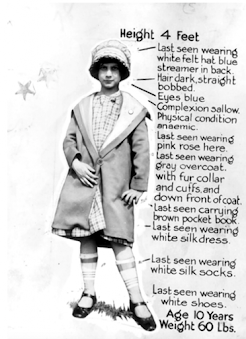
included a photo of the little girl in a hat, coat, and knee socks along with a description of what she last wore and “Complexion -sallow... physical condition - anaemic” [sic]. The photo was cut from a family picture. “He was so kind and fatherly; you wouldn’t think he could step on an insect,” Mrs. Budd sobbed about "Mr. Howard" to the media. “How he fooled us!”
The letter written to scare and shock the Budd family was Albert Fish’s downfall. It was written on stationery from the New York Private Chauffeur’s Benevolent Association. Police would link the stationary to Albert Fish; Fish looked like “Frank Howard.” Fish’s prints on the telegram sent to Edward Budd matched his prints. And when the cops sat down with Fish to interview him, the dowdy old man confessed all with a smile. He boasted he “had killed a child for every state.” As with most cases of serial killers, no one will ever know the number of victims. Grace was one of three murdered children positively linked to Albert Fish.
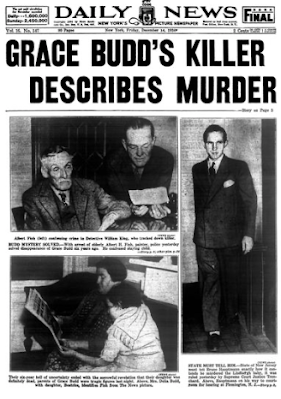 New York Daily News front page,
New York Daily News front page, Dec. 14, 1934. (New York Daily News)
Albert Fish also explained Edward had been the intended torture/murder target until he laid eyes on little Gracie.
Investigators discovered Grace’s skeleton on the grounds of the abandoned house.
Albert Fish was found guilty of murder in 1935 and executed by electric chair in 1936.
Delia Flanagan would never forgive herself for allowing her daughter to leave with Howard/Fish.
This ten-year-old killer did not make headlines
Serious crime committed by a child is usually front-page news. In the case of Otto Newman, his crime barely made a paragraph in the newspapers. That Otto was ten years old when he murdered a playmate was evidently not so fascinating.
December 8, 1896, and Hilliard Otto Newman, 10, played a game of “tag” with Frank Pfeister, 12. They were in the small village of Weber, New Jersey. It was fun and games until the fight. For whatever reasons, the boys began a heated argument. Otto, as he was called, left the game and returned with a gun. He shot Frank dead.
The information is limited, so it’s difficult to know exactly what transpired. It is recorded that police took Otto into custody the same day. Officials locked him up in the Brunswick jail. Otto became one of the youngest prisoners ever arraigned in the state of New Jersey.
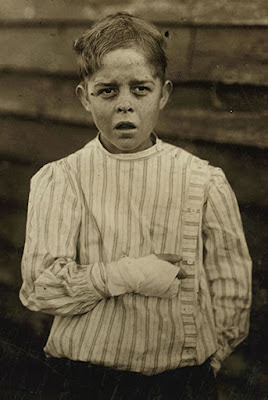 Child laborer (see description below)
Child laborer (see description below)This is not Otto Newman
Times were tough on children Otto’s age. The New York Society for Prevention of Cruelty to Children had been in operation for a little over 20 years, but child labor laws were just seeing change. Children under 14 were no longer working in the factories (legally). The legislation now banned cigar making in tenements, a job done primarily by children. It would be three years before John Dewey, President of the American Psychological Association, began championing children’s rights. Despite the legal changes, thousands of children still worked in factories, toiled in the fields, found work where they could, which was often dangerous and unsafe.
Because Otto’s crime was a capital offense, there was no bail. Otto’s parents tried to visit him weekly. Newspapers listed Otto’s father as Gottlieb Newman, and the family lived in Weber, Middlesex County near Brunswick. Weber, located near the Raritan River, was just southwest of Hopelawn.
The Grand Jury eventually indicted Otto for murder. Until then, the ten-year-old sat incarcerated in the adult jail. Newspaper journalists reported that the boy looked thin and pale and how Otto stayed in a constant state of worry over the case.
Otto did not spend Christmas of 1896 with a turkey dinner, the press noted. The jail served inmates fricasseed chicken, a soup where the meat is pan fried and then stewed in a broth or gravy. Little Otto received several visitors on Christmas day. Some people brought him books. Otto sat in his cell and read for most of his time.
An attorney advised Otto Newman to plea bargain. The attorney asked the courts to reduce the charge of “capitol murder” to “manslaughter.” The day of sentencing, the public packed the courtroom, pushing for a chance to see the child murderer.
On the day of sentencing, Gilbert Collins, the newly appointed Associate Justice of the Supreme Court, was presiding. County Prosecutor John Vorhees agreed to the plea bargain and a suspended sentence. In return, Hilliard Otto Newman was sentenced to the Jamesburg reform school in New Jersey.
Jamesburg, later called the New Jersey Training School, opened in 1867. It would become New Jersey’s largest youth detention center. For Otto, it was a place focusing on rehabilitation and healthy living, destined to keep boys out of trouble and out of adult prisons.
And then the case dropped from the news.
In 1898, the town of Weber became Keasbey. “Postmaster General Gary has ordered that the name of the village … to be changed” (Weber, N.J., Is… 1898). 150 years later, protesters insist the New Jersey Training School be closed.
The fate of the ten-year-old killer is now history, his name only surfacing in the small paragraphs of newspaper archives. There are no photos, no legal paperwork existing. Hilliard Otto Newman lives on only because of a few paragraphs in tattered newsprint.
Resources:
A Murderer at 10. (1897, March 22). Fall River Daily Evening News
A Ten-Year-Old Murderer (1897, March 21) The New York Times
Hawes, J.M. (1991). The Children’s Rights Movement. Twayne Publishers: Woodbridge, CT.
His Christmas a Sad One. (1896, December 26). New York Journal
Weber, N.J., Is No More.; Name Changed to Keasbey After a Long Fight Between Rivals. (1898, April 15). The New York Times
Zoppo, A. (2019, January 16). Hundreds call for closure of N.J.'s largest youth prison. https://www.nj.com/middlesex/2017/06/...IMAGE: Source: Lewis Hine/Library of Congress, photo by Lewis Hine, photographer for the National Child Labor Committee. The boy is Giles E. Newsom. “While working in the Sanders Spinning Mill, a piece of machine fell onto 11-year-old Giles’s foot, crushing his toe. As a result, he fell onto a spinning machine and his hand went into the unprotected gearing, tearing off two of his fingers” (https://socialnewsdaily.com/76614/the...)
May 25, 2021
“Crime Scene Kitchen” bakes up vulgarity
Just when it can’t be more disturbing in true crime television, Fox network has cooked up a show to compete for the ultimate tacky. “Crime Scene Kitchen” has even surpassed “Murder House Flip” – just mix ignorance with disrespect, add tackiness, and you have the recipe.
Fox describes the show: “Each episode of this cooking competition begins at the scene of the crime -- a kitchen that was just used to make an amazing dessert that has since disappeared. The chef teams are challenged to scour the kitchen for clues and ingredients to figure out what was baked. To take the $100,000 prize, the competing dessert makers will need to prove they have the technical know-how, imagination and problem-solving skills needed to decode and re-create incredible desserts and cakes from across the world” [sic]. The trailer features dripping “blood,” crime scene markers, and the host warning, “A beating has taken place” showing the mixing bowl, with “blood” dripping from a knife - yellow crime scene-type tape abounds.

Cooking and crime encompass all that television junkies eat up. Pretty, thin hosts with perfect teeth using euphemisms (cue bright lights, stage smoke). Let the tackiness begin.
Television has evidently run out of “people who kill.” A collection runneth over with killer wives, friends, family members, neighbors, identical twins, animals, etcetera etcetera. Television “personalities” speaking in a careful cadence: “no one would suspect. The killer. Lived nearby. And was evil…” Or leaning in to ask the surviving victims, “How did you feel. When they found. Your loved one cut up. In a dumpster?” Cue slow-motion footage and music.
Real crime scenes never use cadences and music. Television, with some exceptions, has forgotten the victim lying, sometimes in a state of undress, surrounded by a group of strangers for hours. The body may have been raped or violated otherwise. The body is hauled in an impersonal bag to the morgue for cutting, probes, pokes, and photographs. Then comes a trial with those photos laid out to more strangers. It is necessary for the case, but the process is sad, morbid, and invasive. The dead might be a drug-addled prostitute in an alley or a wealthy person in a lovely home. All are someone’s child, a loved one; all victims deserve respect as can be allowed.

Some true crime shows do tell the victim’s story, teach safety, and educate viewers. A crime scene is never cookies and pies with fun and games with applause. Wonder what surviving victims think when they are faced with such.
“Crime Scene Kitchen” has brought true crime television to a new low. I suggest they put it in the oven and burn it.
Images: Fox Television
May 15, 2021
7-year-old survives abduction due to survival skills
A little girl’s escape from kidnappers is one example of teaching children to use survival instincts without creating fear. The case is older, but the repercussions of its lessons still ring out: children can and will use survival skills to avoid succumbing to evil if given the right tools: self-esteem and respect.
In July of 2002, Erica Pratt was seven years old when she played outside her Southwest Philadelphia home. Two men in a car stopped on the street. They called her over to the car; when Erica refused, the driver hopped out to grab her. After the passenger shoved Erica to the floorboard, the car drove away, with Erica kicking and screaming the entire abduction.
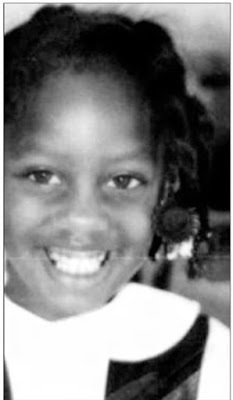 Erica Pratt survived kidnapping
Erica Pratt survived kidnapping
The playmate ran to tell adults. While neighbors immediately begin to fan out across the area, the abductors took Erica into the basement of an empty house. They bound her wrists, wrapped the little girl’s head in duct tape, then locked her in. As night fell, Erica was left alone in total darkness.
As she spent the night in the basement, the captors worked a ransom demand to Erica’s grandmother. Money was the motive in this case. Both men were known criminals in the area. They knew the family. They demanded $150,000, or the little girl would die. During the kidnapping, Erica was allowed to speak to her mother by phone. Her kidnappers told Erica if her grandmother wasn’t forthcoming with the money, “you’ll never see your grandmother again.” Because she loved and respected her grandmother, this was probably the main reason Erica began her escape mission. Genuine fear takes over the brain if we allow it, and it says, “let me show you what to do.”
Erica Pratt listened to genuine fear; the seven-year-old allowed her survival skills to overthrow helplessness. Erica worked her way out of the duct tape, chewing and twisting the binds on her wrists. She forced a hole into the basement door by kicking out a panel, then hurried upstairs in darkness. Erica busted a front window and screamed for help. When two ten-year-old boys heard, they notified “Operation Safe Streets” patrolling officers. In 24 hours, Erica Pratt was safe in her grandmother’s arms. The cops reported Erica was calm upon rescue and able to identify her captors by reviewing a photo lineup. Officers told the media how amazed they were at her “pluckiness.”
Part of the child’s pluckiness was attributed to her grandmother Barbara Pratt, who kept a close eye on her grandchild. They lived in a high crime area, with family members (including both parents) in trouble with the law; Erica was only allowed so far from the yard. Erica had to ask permission to go places outside of the home. Mrs. Pratt volunteered at Erica’s school. She made sure the pretty little girl kept up her grades and used good manners. Erica was to practice safety when riding her bicycle.
Teaching a child to respect others and respect oneself is a core component in building self-esteem. Besides a tool for teamwork, respect begets self-control. And self-esteem is part of survival mode – if you don’t believe in yourself, how can you trust yourself to listen when the brain places you in “survive” mode?
A perpetrator commits a crime for two primary reasons: power and control. They utilize fear tactics to overpower their victim and keep them subdued. People with poor self-control and little sense of self-worth are easier targets. Consider: a child predator purposely seeks children who crave attention and love, who need reassurance.
 Erica Pratt embraced by family after ordeal
Erica Pratt embraced by family after ordealErica was able to escape by chewing and twisting the duct tape binds. Duct tape is of several components that, while strong, also make it easy to manipulate. Rubber is the main component, with a cotton cloth lying between the sticky and topside. That silver backing (or any other color nowadays) is polyethylene, also made to create plastic bags. Try tearing a piece of duct tape longways versus across. One is much easier to rip. And, to loosen duct tape over the mouth, saliva will weaken the glue and cotton, allowing enough space to begin at least partial removal. Erica had a piece of duct tape in her hair when rescued.
The Philadelphia school district where Erica was a student gave commendations to students who were “heroes” – including Erica Pratt – children who deserved recognition for an outstanding act of bravery or leadership. While public recognition can help a child’s confidence, giving them the power of positive thinking comes from immediate peers: caregivers, adults, siblings.
Erica Pratt used survival skills, gifted in part by her grandmother Barbara Pratt, and perhaps from close observation of the price of criminal behavior. Erica fought, then escaped her captors, feeling her way through a dark house in the dead of night. At seven years old, she was a sweet girl who learned proper behavior, the precedent to remaining calm in the face of danger, and even identified her kidnappers. At the core of her survival skills, she had self-respect and esteem. All children have these survival abilities. It is the adult’s job to give them the tools.
Judith A. Yates teaches “common sense self-defense” for all ages in her book “How to Recognize the Devil.” 100% of proceeds are donated to charity. You can purchase it by CLICKING HERE.
Resources
Boyer, B., Cusick, F, Gibbons Jr., T. (2002, July 24). 7-year-old girl flees captors, is home safely. The Philadelphia Inquirer.
Flander, S. (2002, July 24). Erica is her own hero. Philadelphia Daily News.Hinkleman, M. (2002, July 24). Erica is one feisty 7-year-old. Philadelphia Daily News.Kim, J. (2019, January 5). The history behind duct tape and what makes it a handy solution for just about anything. Insider. https://www.businessinsider.com/duct-...Panaritis, M., Porter, I., Soteropoulos, J. (2002, July 24). At core of Phila. mystery’s core, a girl saved. The Philadelphia Inquirer.Panaritis, M., Porter, I., Soteropoulos, J. (2002, July 24). At mystery’s core, a young survivor. The Philadelphia Inquirer.
April 22, 2021
“The State of Texas vs. Melissa” Documentary – know the facts before you judge
A new documentary, “The State of Texas vs. Melissa” directed by Sabrina Van Tassel, is stacking up awards and making headlines. Its subject, death row inmate Melissa Luci, is now garnering the attention of activists and philanthropists. But before jumping on the bandwagon to save Melissa Luci, better ask: do you have all the case facts?
The film depicts Melissa Lucio as a sympathetic character, a victim. She is a victim of child sexual abuse, then domestic violence. As her brood of fourteen children grows, she is fraught with depression, then substance abuse. Still, the film assures us, Lucio takes care of her children the best she can, she loves them dearly, and they love her. Then one day, her baby Mariah falls because of faulty apartment stairs and dies as a result. The all-male police haul her in and force her into a false confession. A victim of the criminal justice system, she becomes the target of a defense attorney and crooked prosecutor. Now Lucio is the victim of the Texas legal system, the first Hispanic woman sentenced to death row in Texas, where she has sat for 13 years. Found guilty of abusing Mariah and causing her subsequent death, Lucio is now appealing her sentence.
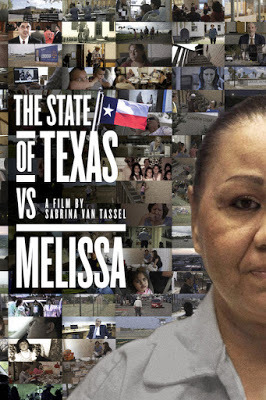 This is not to argue Melissa Lucio’s guilt or innocence. It's about research beyond the documentary before making judgement.
This is not to argue Melissa Lucio’s guilt or innocence. It's about research beyond the documentary before making judgement.Constantly “The State of Texas vs. Melissa” reminds us that Lucio is a victim. The documentary questions the fairness of the trial, touching briefly on the abuse Lucio suffered in her childhood, her drug abuse, the flotsam life she led with her fourteen children in dire poverty (sometimes sleeping in the park), and the “corrupt” and “unfair” legal system that put her on death row. The filmmakers question the prolonged hours of interrogation by officers “without a break” to “force” a confession, the “mistakes” made by a medical examiner on Mariah’s “bruises,” and the “corruption” of the court. The film fails to mention much of what did put Lucio behind bars, what proof juries heard that made them vote Lucio “guilty” of causing Mariah’s death – the actual victim in this horrific case.
The saga began February 17, 2007, when paramedics were dispatched to an apartment Lucio shared with Robert Alvarez, the father of at least seven of her children. Mariah was discovered “unattended and lying on her back in the middle of the floor not breathing and with no pulse.” No one was making any attempt to hold or assist the baby. Lucio told the paramedics Mariah “fell down the stairs.” Mariah was dead upon arrival at the hospital. As discussed at length in the documentary, Mariah was covered in “bruises in various stages of healing.” Details not mentioned are the bite marks on her back, an arm “broken probably about two to seven weeks before her death, and she was missing portions of her hair where it had been pulled out by the roots,” as noted by the ER Physician. A brief interview with the chief forensic pathologist does appear in the documentary, discussing the “blunt force head trauma” caused by a fist, an object, or slamming, not by a fall. Little Mariah also suffered bruised kidneys, a bruised spinal cord, and bruised lungs. The latter information is omitted or glossed over by much discussion over Mariah’s “fall.”
The same night, according to official documents, Melissa Lucio was interrogated from 10:00 p.m. to 3:00 a.m. Not mentioned: about 12:30 a.m., Lucio told a Texas Ranger she began “hitting” and “spanking” Mariah in December 2006, whenever Lucio “got mad” and then several times “day after day.” The documentary focuses on displaying how she would “spank” Mariah using a baby doll. And nowhere in the documentary is Lucio admitting of Lucio confessing how she “pinched Mariah’s vagina … would sometimes grab and squeeze Mariah’s arm … bit Mariah twice on the back at different times about two weeks before Mariah’s death … on one occasion bite Mariah on the back for no reason while combing Mariah’s hair.” Lucio told the investigators, “I just did it.” A toxicology test revealed cocaine in the baby’s blood. Lucio also admitted she “would grab (Mariah) by the arm (and take her down the steps (and) move her around like a rag doll.” On the day Mariah died, Lucio told officers, Lucio feared taking the baby to the doctor, aware the baby was “sick,” because of the multiple bruising.
The police found paraphernalia for smoking crack cocaine in the house that evening. When questioned, Lucio would tell police she stopped using cocaine in February 2006, but “(Robert) Alvarez was smoking crack.”
Lucio’s current appellate lawyer, who is working pro bono, says on camera she is unsure if the entire interrogation video was played during the trial. According to the Court of Criminal Appeals in Texas, No. AP-76,020, the video was played, and the defense tells the jury, apologizing, “it’s a long, long video.”
Based on rumor, the documentary alludes to Lucio’s daughter as responsible for the baby’s death. There is a brief interview with the suspected culprit. There is no mention of Lucio’s phone conversation with her sister, where Lucio was heard saying, “This was me. I did it (killed Mariah).”
Melissa Lucio is interviewed via death row inmate visitation, speaking on a telephone from behind a plexiglass partition. She smiles sadly and recalls the fun times she had with her children. She says of “combing Mariah’s hair…putting lipstick on her lips… painting her nails and toenails” and her family sitting around the dinner table enjoying a meal with her kids saying, “yum-yum, this is good, mom.” Everyone in her family is woeful that Lucio is growing older without her children. The forgotten part of the story?
Child Protective Services (CPS) has documented numerous contacts with Melissa Lucio:
1995, 1996, 1998, 2000, 2001, 2002, 2003, and 2004: allegations, usually involving neglect and neglectful supervision, were investigated by CPS, and Lucio tested positive for cocaine. Two of Lucio’s newborns tested positive for cocaine.
2004: three-week-old Mariah and all the children living with Lucio were removed for physical neglect and negligent supervision. Although Lucio visited Mariah in foster care and all children were returned to her on November 21, 2006, Lucio would admit to police she was not close to Mariah as a result.
CPS observed bugs on the floor and mattress where Mariah slept. A window fan had no cover. There was sparse food, primarily rotten. The home reeked of urine. The children smelled, were filthy, some with dried feces in their genital areas. They all had scratches, bruising, and one had an infected sore with pus. All had open insect bites. Melissa Lucio tested positive for cocaine but denied using.
There was “concern for the children’s safety, (with all children suffering) bruises, scratches, scabs, bites, and general filth.” The children were removed from the home due to “poor physical conditions of the children and the home, the lack of food in the home, the neglectful supervision of the children, past and present drug use, previous CPS history, and no viable voluntary placements for the children.”
2004-2006: Drug tests reveal Lucio testing “17 or 18 positives and about 11 negatives.”
Lucio and her “husband” received $2,400 - $5,000 a month from welfare benefits (including food stamps) and work, but she was using the money to purchase cocaine. They never used the services for rent (the family was constantly evicted), furniture (Lucio’s family members admit she would grub through trash for furnishings), medical care, or food.
And her abusive behavior did not stop once jailed, before trial. Melissa Lucio received write-ups for physical and verbal altercations, possession of contraband, unauthorized communication, inciting a riot, and confrontational behavior towards the staff.
This is not to argue Melissa Lucio’s guilt or innocence. The problem is how a slanted or biased documentary creates a cause célèbre out of an inmate (à la “Making A Murder’s” Steven Avery) and a bandwagon for “justice” without knowing all the facts. Before becoming a fan of an incarcerated person and screaming “racist, crooked, system!” know the facts of the case and research beyond the documentary. Melissa Lucio being Hispanic is a big part of the story; race and wealth are indeed circumstances in death row sentencing but should not be the sole reason in determining innocent, too often a knee-jerk reaction.
Director Sabrina Van Tassel has said of The State of Texas vs. Melissa, “It’s taught me … not to judge hastily.” Oh, really?
Resources
Asgarian, R. (November 6, 2020). Did Melissa Lucio, the First Hispanic Woman on Death Row in Texas, Kill Her daughter? An Uneven New Documentary Raises More Questions Than Answers. Texas Monthly. https://www.texasmonthly.com/arts-ent...
Melissa E. Lucio v. The State of Texas (September 14, 2011). No. Ap-76, 020. Cause no. 07-CR-885-B. http://www.ca5.uscourts.gov/opinions/unpub/16/16-70027.1.pdf
Melissa E. Lucio v. The State of Texas (September 14, 2011). No. Ap-76, 020. Cause no. 07-CR-885-B. https://caselaw.findlaw.com/tx-court-...
ViewPoints. (N.D.) “The State of Texas vs. Melissa.” Tribecca Film Festival. https://tribecafilm.com/films/state-o...
Van Tassel, S., Director. (January 19, 2021). de Bourbon, P., Sharry, I., & Van Tassel, S. (Producers). “The State of Texas vs. Melissa.” FilmRise.
Van Tassel, S. (October 26, 2020). Following My Instincts. https://www.talkhouse.com/following-m...
Photo: IMDb.com
April 16, 2021
The Granny Grifters: Helen Golay Olga Rutterschmidt not typical serial killers
“You’re going to go to jail, honey. They’re going to lock you up.” The two females sat together in the interrogation room of the Los Angeles police department. As they had refused to speak to detectives, the investigators decided to place them together, alone, secretly recorded.
The second woman advised the other to stay quiet. “They could be taping us!” She hissed.
But her friend refused to listen. “You did all these ... insurances extra. That’s what raised the suspicion. You can’t do that. Stupidity!” And with those words, she helped seal their fate after a nine-month investigation. Both women had amassed a total of $674,571.89 in insurance fraud. What made the case so unbelievable: Olga Rutterschmidt was close to seventy years old at the time of the murders. Her partner who shushed her, Helen Golay, was a few years older.
Olga Rutterschmidt was born in Hungary in 1933. She learned at an early age how to survive by wits and deceit with a war-torn country and class system her mentor. Eventually, she would marry, and the couple emigrated to the United States in 1957 to own a small business. They would divorce, and Olga moved to a Hollywood apartment in the 1970s. She was known as the eccentric tenant, who complained loudly about anything and everything. Olga filed personal injury claims every few years and collected the money.
 Helen Golay & Olga Rutterschmidt
Helen Golay & Olga RutterschmidtTexan Helen Golay was born in 1931 and bounced from relative to relative until landing in the foster care system. When she was old enough, she packed her bags and headed for Los Angeles. Helen invested in real estate, purchasing apartments to rent out. But it was a bad market for landlords, and Helen began losing money, so she schemed up ways to make money by charging fines for minor discrepancies and taking boarders to court.
When Helen met Olga at a local gym, hell broke loose for future defenseless victims.
Helen and Olga began doing volunteer work at Hollywood’s First Presbyterian Church, assisting homeless people. They were known as sweet and gregarious “grandmas,” always having kind words and helping hands. The kind old women even volunteered free apartments for men who needed extra care.
In 1997, Olga and Helen took in seventy-one-year-old homeless man Paul Vados. Olga was the caregiver, with her soft, sweet Hungarian accent and natural charm. Helen rented out the apartments for the homeless men. Helen kept meticulous record books, including eight different life insurance policies on Paul, listing the women as the beneficiaries. In 1999, Paul was discovered lying dead in a Hollywood, California alley, covered with tire tracks and drag marks, crushed and sopping wet as it had rained heavily the night he died. Paul was tiny, missing most of his teeth, the result of the mean streets and alcoholism. Two women claimed his body: septuagenarians Helen Golay and Olga Rutterschmidt. They reported as “next of kin.”
On June 21, 2005, fifty-year-old homeless man Kenneth McDavid was found dead in a backstreet, another victim of a hit-and-run. Sedatives had flowed through Kenneth’s bloodstream. Soon after, two women appeared at the LAPD police station, inquiring about his death. They were his fiancée, Helen Golay, and his business partner, Olga Rutterschmidt. Olga and Helen, from November 2002 to March 2003, had cared for Kenneth. Saddened and distraught over his horrific death, the women also asked about Kenneth’s insurance policies. The women had thirteen policies on Kenneth, $3,700,000.00 worth. Each policy listed these women as either Kenneth’s fiancée, business partner, or cousin. The money was eventually collected when Helen wrote a threatening letter to the insurance agency. They buried their “beloved” Kenneth McDavid in an unmarked potter’s field.
They schemed together, but they also worked alone. There were times Olga would take out a policy when Helen was unaware. Helen had her side businesses. Helen amassed various properties, including land in Playa del Rey. The possession of this property was sketchy: When a developer named Artie Aaron died, somehow Helen was willed the deeds to a few of Artie’s properties. Artie’s families were unaware of these transactions until after his death. While Helen loved the status and fancy goods of wealth, Olga lived in Section 8 housing, stole her neighbor’s mail, and continued with disability claims. One case had Olga suing a La Brea Avenue coffee shop manager, claiming her food caused a fight between herself and another customer. Olga claimed the customer used a stun gun on Olga; Olga claimed physical injuries and emotional trauma.
Jimmy Covington, 48, had no place to live and little to live on. Olga Rutterschmidt treated Jimmy to a fast food meal when she asked him to move into Helen’s apartments. She told him Helen would help him obtain benefits while Olga would cook and care for him. It sounded great, and Jimmy moved in, but then the women began making demands. They asked him to sign documents they would not explain; they wanted his social security number and birthdate. Jimmy discovered later at trial: Olga Rutterschmidt and Helen Golay had completed at least one life insurance policy application for Jimmy Covington as beneficiaries without his knowledge.
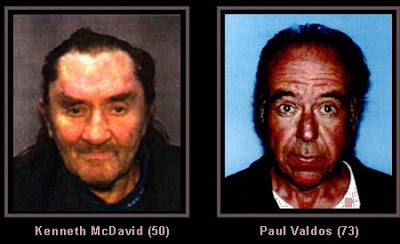
They spotted Olga in the company of Mr. Josef Gabor, a frail, older man. Josef was a loner, with an apartment above the Hungarian Reformed Church. Surveillance cameras snapped as she talked to Josef, papers in her hand, pointing to the documents. Then she drove Josef to a bank. It was the beginning of the scam. When opening a checking account, the unsuspecting men would be offered a free thousand-dollar policy. Soon the policy would increase. In time it would grow more. While there was not enough evidence for the murder, there was enough for mail fraud. And no one wanted to allow the women time to fleece another soul. It was May 2006. Investigators arrested the two women separately, with Helen protesting loudly.
Detectives had discovered a covert security surveillance camera had videotaped the vehicle causing Kenneth McDavid’s murder, but the video was of poor quality. The video “cleaned up” revealed a silver 1999 Mercury Sable station wagon pulling into the alley on June 21, 2005. The car cut its lights, made a series of pulling in and out, then departed. By interviewing neighbors, detectives learned Helen Golay drove a Mercury Sable station wagon- one neighbor provided a photo with the car in the background. (Helen did own the car – she had purchased it using a stolen driver’s license.) The VIN was traced. The vehicle was found dumped, was towed, and sold at auction, and the new owners were an unsuspecting family. Once in the forensics lab, crime scene techs found Kenneth McDavid’s blood and DNA in the station wagon’s undercarriage.
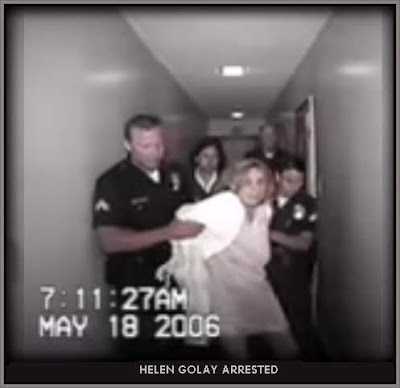
Despite the investigator’s best tactics, Olga and Helen would not say a word when taken individually into the interrogation room. So the two women were left alone, together, in the room, unknowingly being recorded as the investigators watched. The video helped determine their future. “You did all these g**da*n insurances extras!” Olga cursed at Helen. Helen kept warning Olga to hush. Helen seemed to think they still had a chance. Olga appears as if she has accepted their fate.
The women pleaded "not guilty" to the murders and nine counts of fraud. Both women received consecutive life terms in California’s Chowchilla prison without the possibility of parole. Helen was 77, Olga was 75. The courts have denied their numerous appeals. At this writing, Helen is 90; Olga is 88. According to several people, they are still attempting scams.
References
Brownfield, P. (October 23, 2015). “What Can I Tell You?” Los Angeles Magazine. https://www.lamag.com/longform/what-can-i-tell-you/
Smith, T. (2016). Killer Granny: The True Story of Serial Killer Helen Golay. CreateSpace Independent Publishing Platform.
California v. Olga Rutterschmidt & Helen Golay. (September 18, 2009). 2 CRIM.B209568: LASC BA306576. File # S176213.
Goldenberg, Suzanne (2008-04-18). "Elderly women face jail over insurance killings". The Guardian.
Golden Years - Wicked Attraction. (July 16, 2009). Mann, S. (Director) Armodio, J. (Writer). Investigation Discovery. Season 2, Episode 2.
Hong, Peter Y. "Women Plead Not Guilty in Deaths of Transients; Helen Golay and Olga Rutterschmidt are Accused of Killing Men for Insurance Money]." Los Angeles Times, Sep 14, 2006. ProQuest Global Newsstream.
King, J. (2009) Signed in Blood. St. Martin’s True Crime: NY
March 10, 2021
Walmart teen girls stabbing a horrific story – for a while
 "The" photo of January 2021: Regan
"The" photo of January 2021: Regan running out of the Walmart, after
the murder.
The video jostles through much of the rest, but the victim, Melanie Lyons, is observed charging down the aisle. “Yeah, we’re about to come outside as soon as my sisters come-“someone in Raegan’s group shouts. “Bitch, don’t fuc*ing tempt me!” Raegan lunges. Terrifying screams echo throughout the store. “Oh, Lord Jesus Christ! One of the girls, near the cellphone, shouts. Next, they are seen in an unknown vehicle. “Raegan just stabbed somebody at Walmart,” one of them shouts into the camera. “We just stabbed a bitch in the heart, and we don’t give a fuc*!” Then, “She looked at us and was like, ‘Oh, I’m bleeding…’” Another voice agrees. “She leakin’.”It began in a movie theatre where Melanie, celebrating her fifteenth birthday, was gathering with friends. One story has it there was a fight over a boy. Another has Melanie and her group “bumping into each other.” Each group left the movies and walked over to the store, where the aggressors went to the kitchen goods aisle to steal a knife from a plastic pack. Each of the families blames the other for which teen was the aggressor; Regan’s family claims self-defense, while Melanie’s family claims cold-blooded murder. And at the end of the night, the girls line up for the video finale, where the girl in the bonnet makes her statement. The girls talk over one another as they add, “We’re sorry we (called the victim names). This is to – what’s the (victim’s) name? Melanie?” “We’re sorry, ya’ll. It coulda been one of my sisters” says one of the girls. “Yeah,” the bonneted girl adds laconically.In the aftermath, four teens are sitting in jail, one with a charge of second-degree murder and three for being principals to second-degree murder. One teen lies in a coffin. Five families are grieving in various ways. There is in-fighting, rumor and innuendo, online blame-gaming, and much, much judgment. But the worst part of all, that we know for sure? In a month, it will all be history for the public.
Resources: Injustice Investigations News Media 7 YouTube Vlog (2021, Jan. 27). “Louisiana teen stabbed to death in Walmart.” https://youtu.be/I3Cqarwqt_s https://www.lipstickalley.com/threads... Morris, J. (2021, Jan. 25). “Walmart Stabbing Louisiana Video: Facebook and Instagram Live Stream, 15 year old girl murdered.” https://www.youtube.com/watch?v=_uM7F... Kwong, J. (2020, Jan.27). “She Dead Now.” The U.S. Sun. https://www.the-sun.com/news/2222767/... Ghosh, R. (2021, Jan. 26). “4 Teenage Girls Stab and Kill 15-Yr-Old at Walmart; Horrific Murder Livestreamed on Social Media.” International Business Times. https://www.ibtimes.sg/four-teenage-g...



